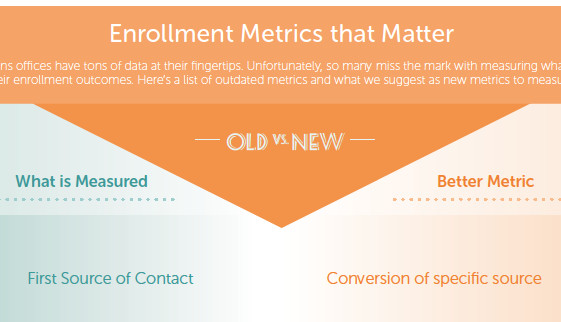
Enrollment Metrics That Really Matter (Part 1)
This post is the first in a series where I will discuss a currently used metric and it's limitations, as well as provide an alternative that may be a better indicator of the value of that recruitment effort. Like the infographic above? Click here to view the whole thing!
One of the biggest causes of headaches for many enrollment managers is constantly being challenged to hit ever-increasing goals while continuing to be asked to do more with less. Yet, when tasked with finding efficiencies these same enrollment managers seem hell bent on sticking to the status quo, or worse, use their "gut" to make data-driven decisions.
With the cost and value of higher education under seemingly unending scrutiny, why don't we consider re-thinking how we measure success and use technology and data to support our decision-making?
Metrics that Matter
Too often we get caught in the rabbit hole of looking at today's student behavior through the lense of admissions marketing from 10 years ago. The reality is that today's admissions marketing landscape is more like that of a digital marketing organization than ever before. What worked as a metric before might not work as well today. This is why our team has developed a quick and easy to understand infographic to help you visually see what outdated metrics you are likely using with suggestions for what metrics you can change.
What's the point of first source?
One of the most frequently thrown out terms for evaluating an inquiry source is "first source" or "first point of contact". While this metric may be OK to see where you are starting the conversation with students, it is hardly the be-all-end-all that it used to be. Students stop and start their college search pretty frequently, and use a variety of sources to inform their decision. In my post, "Recruiting the iGeneration", I mentioned that today's prospects are doing their search on their own terms; which means many are doing their research on their own time, via their preferred channel ... and based on the recent Social Admissions Report we know that this search starts on digital, continues via mobile, and ends on social.
If we all agree that students are using various sources, and we also agree that they are doing their research "on their own time", then why do we continue to measure first source (which oftentimes is a large list name buy of a students who may or may not have heard of you or have been interested in hearing from you at the time you bought them) as a primary benchmark when evaluating our recruitment metrics, especially when the conversion of "lead" (bought name) to "inquiry" (request for information) is so low?
Focus on conversions
I suggest (even "in addition" to first source if you must) looking at conversion of that source from inquiry through enrollment regardless of the point of contact of that student. In digital marketing (which is what admissions recruitment IS nowadays) it's not about the first point of contact with a prospect ... it's about what contact caused action and conversion throughout the funnel.
Too often people discount the secondary point of contact because they say "well, we would have gotten that kid anyway." Yet, these are the same people that attend every college fair and visit every high school they can, and don't care if the students they meet are already in their pipeline or not ... They simply do it out of a "this is the way we've always done it" mentality.
Any "name buy" source can easily be your top first point of contact if you have enough money to buy every name you want ... but wouldn't you rather save money acquiring your prospects and shift those funds to yield-based activities where it really counts? Look at more than just the number of students in your class coming from each source and look at the conversion of each source at each phase of the cycle.
- If I get a lot of applications from a source but none of them are admitted, is this really a good source? Maybe to boost your US News Ranking but not to hit your goals.
- If I accept a lot of students from a specific source but none of them enroll, is this really a good source?
- What's the retention rate on my top enrollment sources? If those kids leave after one year, is this really the best "fit"?
Check out the "Enrollment Metrics that Matter" infographic over on the Chegg blog, and consider re-thinking how you measure your recruitment efforts. When you start to "recruit smarter" you begin seeing better outcomes for both students and for your school.
Gil, too true! " In digital marketing (which is what admissions recruitment IS nowadays) it's not about the first point of contact with a prospect ... it's about what contact caused action and conversion throughout the funnel."
Owner, Square One Consulting 📚 Chief Marketing Officer, Be Light Care Consulting 🧠 | 15+ Year Higher Education Veteran 🏫 | Slate Comms Super User 💻
9yCan I say, AMEN? :) I'm looking forward to forwarding this series to some people!
CMO at Industry West
9y"wouldn't you rather save money acquiring your prospects and shift those funds to yield-based activities where it really counts?" Well put!
I teach things…but I’m mostly learning.
9yGil, I've always liked your innovative approach to admissions. The colleges/universities that adopt a digital marketering approach will reap major benefits and see their efficiencies increase as well. Keep up the great work my friend!